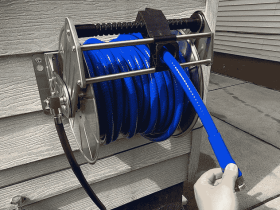Plumbing issues are quite common and inevitable when owning a home. It is quite likely that you will face such problems at some point in your life. While some of these plumbing issues are due to wear and tear of plumbing equipment, others are because the systems are well-used and not properly maintained. Thus, it is essential to know what the most common plumbing issues are, their causes, how to avoid plumbing problems and solve them. So, let’s get started!
What is plumbing issues meaning? And What are the plumbing issues?
Plumbing issues mean some problems that help to obstacles your plumbing system.
A few different types of problems can come up with your plumbing system. It can come in all sorts of shapes and sizes.
There are minor and inexpensive problems like running toilets or dripping faucets on one end. Conversely, some serious problems exist, like a major pipe leak or a sewage system backup. It can cause severe structural damage to the property and might even destroy the home’s contents.
Sometimes you can fix these issues by replacing parts in your plumbing system (or hiring a plumber to do so). However, there may also be other factors involved besides age or wear and tear on equipment that causes these problems.
According to experts, a small plumbing issue like a household leak can waste approximately 9,400 gallons of water annually. If left unchecked, it can seriously hurt your wallet and resources.
The problem with plumbing issues is that many of them can go undetected and will only be discovered at their breaking point. It can lead to more expensive repairs, inconvenience, and hassle.
In the following discussion, let us look at the most common problems in plumbing systems that homeowners should know about, causes and their quick fixes.
8 Most Common Plumbing Problems, What Causes Plumbing Issues, and How To Avoid Them
Here are the top plumbing problems and their solutions homeowners should know about.
1. Leaky Faucets
The annoying sound of a dripping faucet is frequently connected to madness. The steady beat leaves a permanent imprint on your brain. Even when you’re not at home, you start to hear it.
Around 2600 gallons per year are wasted with one drip per second. As your patience wanes, so does your water bill. Don’t worry. A proper diagnosis and fixing will remedy it.
What are the possible causes?
Worn O-ring: Changing the o-ring is the quickest and most inexpensive way to fix a dripping tap. This tiny rubber ring fits over the stem screw. Holding the handle firmly in place is helpful.
This ring wears out over time from the handle being pulled and pushed. The water leaks usually begin at the base.
Old Cartridge: Another biggest contributor to water leaks is the aerator. It is the mesh filter located at the end of the spigot. The mineral deposits can clog the aerator over time, resulting in the eventual loss of water pressure and causing stress to the gaskets and seals. To avoid this problem, make it a point to change them every two years.
Bad Washer or Valve Seat: The valve seat and washer are located between the faucet and the spout. If these connections deteriorate or become loose, you may experience a leak at the spout. Another reason could be the mineral deposits that erode the valve seat. Inappropriately sized washers can also cause problems. Friction causes the washer to become loose and leak water if the seat does not fit well.
How to Avoid the Problem?
You cannot avoid natural wear from frequent use of the faucet. Leaking faucets are inevitable. However, you can prolong the life of your faucet by using it with care. Although it is hard to prevent leaky faucets, you can find the issue earlier through routine inspection. Search for moisture and tiny drips. It may be possible to detect leaks by looking for visible rusting or white lime deposits.
2. Leaking Pipes
Most plumbing issues are caused by pipes, particularly in older homes. Nowadays, PVC makes up the majority of pipes. However, copper pipes are still prevalent in many older structures.
Under typical conditions, copper is more durable than PVC. The issue is that copper performs poorly during extreme temperature changes. Copper will break due to the expansion and contracting, while PVC flexes.
What are the possible causes?
Broken seals: Many appliances in the plumbing system have seals around the connectors. If you see condensation around the appliances, it has a broken water seal.
High water pressure: The pipes can only handle a maximum of 60 psi of water pressure. High pressure may be good for the shower but can cause leaking pipes.
Pipe corrosion: Copper pipes tend to rust. If you notice discoloration or dripping around the pipes or signs of warping, you should call a plumber.
How to Avoid the Problem?
To stop pipes from leaking, extensive maintenance and upkeep are required. Regardless of the material, they are composed of, learn how to prepare your pipes for the winter. Checking the integrity of the pipes should be first on the list. It supports the importance of HVAC inspection.
3. Toilet Leaks
Toilet leaks frequently go unreported. An internal leak in the tank results in water draining down the drain rather than producing a noticeable mess on your floor. If you don’t notice it, money will go down the drain.
What are the possible causes?
Sagging rubber flapper: A perpetually running toilet may leak hundreds of liters every day. The rubber flapper is one of the main offenders. They may sag and fail to effectively seal the tank.
Twisted chain: The chain that is fastened to the flapper occasionally twists. By doing this, the flapper would be kept from resting flat on the floor.
Fortunately, fixing the flapper is simple and affordable. The full flushing system is available for less than $20. Additionally, you can test for toilet leaks at home.
How to Avoid the Problem?
By just flushing soluble garbage down the toilet, you can avoid clogs. Keep an eye on kids to prevent them from flushing toys or other bulky items down the toilet. If anything accidentally falls into the toilet, remove it rather than attempting to flush it.
4. Worn Out Hose Bibb
The typical hose bibb is not made to last for several seasons. It is more evident if you reside somewhere with severe winters. The temperature difference will cause the hose bibb to break and lose its integrity.
What are the possible causes?
When the hose bibb breaks, it will leak water everywhere. Hundreds of gallons can be silently lost each month due to a leaking hose bibb.
How to Avoid the Problem?
If you don’t want to have to replace them all the time throughout your home, buy a heavy-duty frost-proof brand.
5. Clogs and Partial Clogs
Clogged pipes are a significant cause of frustration for homeowners. Toilet blockages are usually rather simple. A pipe snake or plumber may be required for the severe obstructions, but otherwise, just plunge.
Drain and sink clogs, however, are on another level. It can be tempting to reach for drain cleaners when problems get extremely severe. But such an instantaneous remedy is not advisable. They occasionally work, but frequently they are ineffective against anything that can clog your drains.
What are the possible causes?
When something entirely or partially obstructs the drain, it becomes slow or clogged. Hair is frequently the problem in sinks and showers, but other objects, like a shampoo cap or a small toy, can get down the drain and clog the pipe.
Another frequent cause are tissues. It can be difficult or impossible for water to get through the obstruction and down the pipes because those heavy objects cannot pass through the pipe and remain there.
How to Avoid the Problem?
Always ensure that you have strainers on your drains to avoid these objects from clogging your drains. Use a hair catcher over the drain in showers to prevent hair from accumulating inside the drain pipe. To avoid clogging, try to keep hair strands out of sinks.
6. Hot Water Issues
It isn’t nice to discover that your water heater isn’t functioning. Cold water showers without hot water won’t be enjoyable unless your house is warm inside. If not properly maintained, the water heater may not reach its 8–13-year lifespan.
What are the possible causes?
Rust and Corrosion: The quality of a water heater depends on the enclosure it is housed in. You can find them better if they are inside the house. But over time, water heaters can have problems with external elements too. Anode rods can stop corrosion. However, they progressively lose their effectiveness. The tank may corrode as the rods weaken with age.
Sedimentary Build-up: Diverse minerals found in hard water settle at the bottom of the tank. The silt may clog pipes, reducing water flow and water pressure. Professional cleaning is required to avoid long-term harm to the water heater itself.
Inadequate Pressure and Size: Water heaters are not a one-size-fits-all type. Apartments with 1-2 bedrooms require a smaller heater than homes with 4-5 bedrooms. If your heater is small and used frequently, it won’t last very long. The water heater’s heating elements require adequate cooling cycles to avoid shortages. Additionally, you must ensure that the water pressure level is set up adequately for your requirements. Too much water pressure might shorten the life of the water heater.
How to Avoid the Problem?
By maintaining the water heater, you will avoid hot water issues. Also, regular checking of the pressure and removing the sediment periodically will avoid these potential problems. Watch out for drips and leaks, which are signs of more significant hot water concerns.
7. Sewer Blockages
One of the least enjoyable plumbing issues you must diagnose is this one. Back-ups in sewer systems can produce nauseating odors. All of your drains may become clogged if the sewage line becomes blocked.
When water accumulates in your sink and every flush acts like a clog, you’ll know the problem is with the sewage line. We advise hiring a licensed plumber to handle any repairs to sewer lines. Here, preventing sewer issues is the best course of action.
What are the possible causes?
Use caution before flushing anything. Some face and cosmetic wipes contain fibers that prevent them from decomposing quickly enough. These may combine with “other” components to produce a kind of toilet concrete, and they will do so.
Another cause of sewer obstructions is food. It’s not a good idea to flush food down the toilet. Try to be wise about how frequently you use your waste disposal if you have one.
Even if it can chew through it, gradually scrape the food down there rather than throwing the entire dish away. Larger food fragments occasionally escaping the garbage disposal can cause a sewage line backup. Observe the grease as well. Pouring your grease down the drain is risky. It may descend as a liquid and later solidify. If it does happen, run hot water on the drains to ensure the water is clear.
How to Avoid the Problem?
One way to prevent sewage issues is to avoid throwing leftover food and grease down the drain. You should also keep the soap scum and hair out of the bathroom. Put a mesh strainer on the tub and shower drains. Lastly, watch what you flush. Avoid flushing stringy, dense, bulky materials that can cause a clog.
8. Low Water Pressure
Low pressure is probably the most unpleasant issue in most houses, besides that leaky faucet. Showering is less comfortable, and washing dishes is challenging when there is little water pressure. A new showerhead or faucet might occasionally make a low pressure go away.
What are the possible causes?
Low water pressure serves as a warning for other possible issues in your plumbing system. It could be a pipe problem somewhere or a leak you are unaware of. A break in the water main can be a possible reason why the water pressure is low. Another potential cause is the build-up of sediments and minerals on the pipes and in the faucet. This buildup can slow the water flow and lower the pressure.
How to Avoid the Problem?
The best possible solution to avoid this problem is to install a filtration system. It will filter the minerals and avoid build-up. Also, inspect your pipes for leaks regularly and get them repaired immediately.
Conclusion
The key to avoiding plumbing problems has the right equipment, knowledge, and preparation. Knowing what you are up against, what might be wrong, and how to prevent it is essential in any common home maintenance problems.
It is important to remember that plumbing issues may indicate potentially bigger, more serious trouble. For example, clogs on your sink might result from a collapsed line, or a leak in the washing machine could mean that your water pressure tank has a leak somewhere.
As such, you should pay attention to even a small plumbing problem. When you have a basic knowledge of your home’s plumbing system, you can instantly spot the problems and avoid costly damages.
Relevant searches:
Signs of plumbing problems, difficult plumbing problems, how to fix plumbing problems, plumbing issues in house, how to prevent plumbing issues, how do you know if you have plumbing problems











Leave a Review